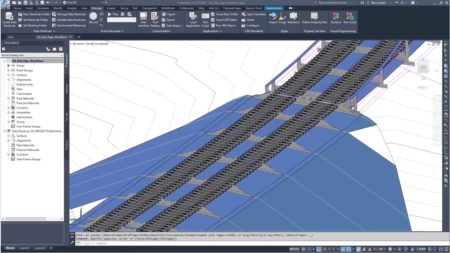Autodesk Civil 3D 2020 is the latest release of one of Autodesk’s key infrastructure software packages and the company is particularly excited about the introduction of Dynamo for Civil 3D.
Civil 3D 2020 — What’s New
The latest Civil 3D 2020 improves on performance and scalability across a range of functions, in addition to the new Dynamo integration, which we’ll delve into in a moment.
The first thing existing users will notice about the 2020 release will be the updated user-interface (UI). A dark blue theme runs across the ribbon background and icons are newly updated to better respond to 4k displays. The cosmetic improvements are designed not just for better UI-UX but also to tie together all of Autodesk’s AEC Collection applications.

01 – Dynamo for Civil 3D is the star of the new 2020 release of Autodesk’s civil design software package.
There are new storm and sanitary analysis tools that aid the engineer or user in analyzing multiple storm events. When working with dimensionless hydrographs you can now adjust the peak rate factor for the hydrograph on a per sub-basis basis. There are also new updates to the gravity network command that help users analyzing a gravity pipe network while in the model.
Dynamo Integration
Dynamo is the star of the 2020 release of Civil 3D. Autodesk says that with it Civil 3D enters “the next era of design automation and computational BIM.”
Indeed, customers will be able to iterate, automate and solve complex designs order of magnitude faster than manually modeling each iteration they may conceive and wish to test out. Users do not need to have advanced knowledge or Dynamo to get started either. Dynamo for Civil 3D comes with sample scripts to aid onboarding to this new automatable design environment.
Engineers at Belgium’s TUC Rail, for example, are already utilizing Dynamo to great success. “Dynamo gives me the means to be more flexible and quick in solution adoption. In my experience, we hope that civil projects are standard, but every time you find that you need something a bit different,” says Woulter Bulens, TUC Rail. “With the right nodes, it will be easier to create a variation and test something new.”
“I look forward to drafters use of this tool,” he adds. “This is simply next level in scripting with not just AutoCAD, not just Civil 3D, but geometry and data as a whole. As a programmer, I am very happy with the visual engine of Dynamo to support programming with geometry.”
For readers in engineering who want to know more, they can read this Autodesk blog post here on “Get under the hood with Dynamo for Civil 3D” or learn more about Autodesk Civil 3D 2020 here.
Architosh Analysis and Commentary
Infrastructure projects like bridges, roadways, rail tracks, et cetera, are massively repetitive across typical engineered systems. Dynamo can take model element sections like rail track and extrude it across parameters, set increment changes, and provide readable data from CSV files. If the linked input from a node in Dynamo connecting to a spreadsheet changes (ie: changing a value in a spreadsheet) the 3D model in Civil 3D 2020 automatically changes.
Infrastructure needs are estimated to outstrip delivery based on current governmental funding allocations, but even if the funding is met by a modest but significant increase from 3 percent of GDP to 3.5 percent of GDP for each country, engineers and infrastructure design professionals still need more rapid ways to deliver solutions. With Dynamo integrated into civil design workflows, faster iterative workflows are possible.
In general, computational design or what we at Architosh refer to as algorithmic-aided design (AAD), is set to be a significant growth area within the larger CAD/BIM industries for the very fact that their integrations can transform the design and engineering process for all—not just expert coder-types working within AEC. Integrating common-use scripts and lowering the slope of on-ramping existing users to these new workflows will all work towards meeting significant goals with infrastructure design. This is why AAD is a key emergent technology (emTech) identified and discussed at larger lengths inside Architosh’s new free monthly newsletter INSIDER Xpresso.




Reader Comments
Comments for this story are closed